Kentucky’s diverse landscapes host a captivating array of owl species, showcasing nature’s nocturnal wonders. The state is home to eight distinct owl species, from the iconic snowy owl to the elusive northern saw-whet owl.
In this exploration, we unravel these majestic birds’ unique characteristics and habitats. Each species contributes to the intricate tapestry of Kentucky’s ecosystems, playing a vital role in maintaining the balance of nature.
Join us on a journey through dense woodlands, expansive parks, and serene wildlife refuges to uncover the enchanting world of the eight species of owls that call Kentucky home.
Discover their behaviors, habitats, and the delicate dance of life that unfolds under the moonlit Kentucky skies. Stay sharp.
8 Owls Of Kentucky
Kentucky’s diverse landscapes host a variety of owl species, each with unique characteristics. From the iconic snowy owl to the elusive northern saw-whet owl, these fascinating birds play vital roles in their ecosystems.
Explore the distinct lifestyles and attributes of the owls that call Kentucky home.
1. Barn Owl
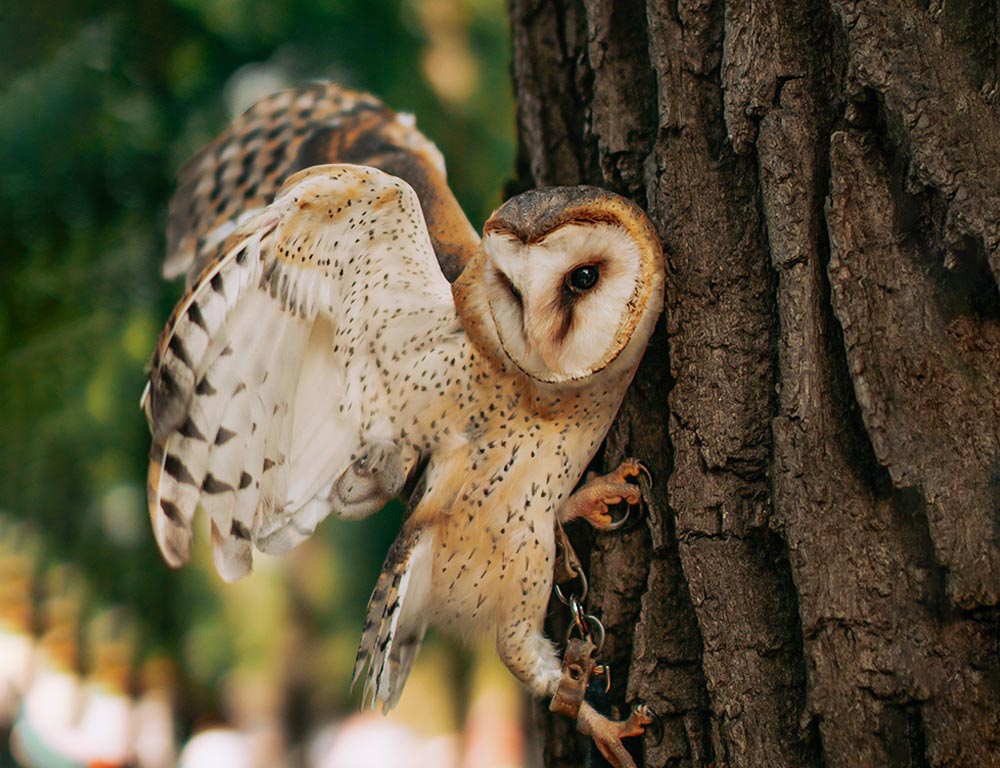
- Scientific name: Tyto alba
- Population: Varies but stable
- Life span: Up to 10 years
- Size: 12-15 inches
- Weight: 1-1.5 pounds
- Food: Mainly small mammals like mice and voles
- Wingspan: 42-43 inches
- Status: Common
Barn Owls (Tyto alba) are nocturnal birds known for their distinctive heart-shaped facial disks. They have a global distribution, and their population remains stable in Kentucky.
With a life span of up to 10 years, these medium-sized owls exhibit a wingspan of 42-43 inches and a weight ranging from 1 to 1.5 pounds. Barn Owls are efficient hunters, primarily preying on small mammals, especially mice and voles.
Their silent flight, aided by specialized feathers, helps them approach prey quietly. Barn Owls often nest in barns, abandoned buildings, or tree hollows.
Their adaptability to various environments contributes to their common status in Kentucky. Despite their widespread presence, habitat loss and pesticide use can impact their population.
2. Great Horned Owl
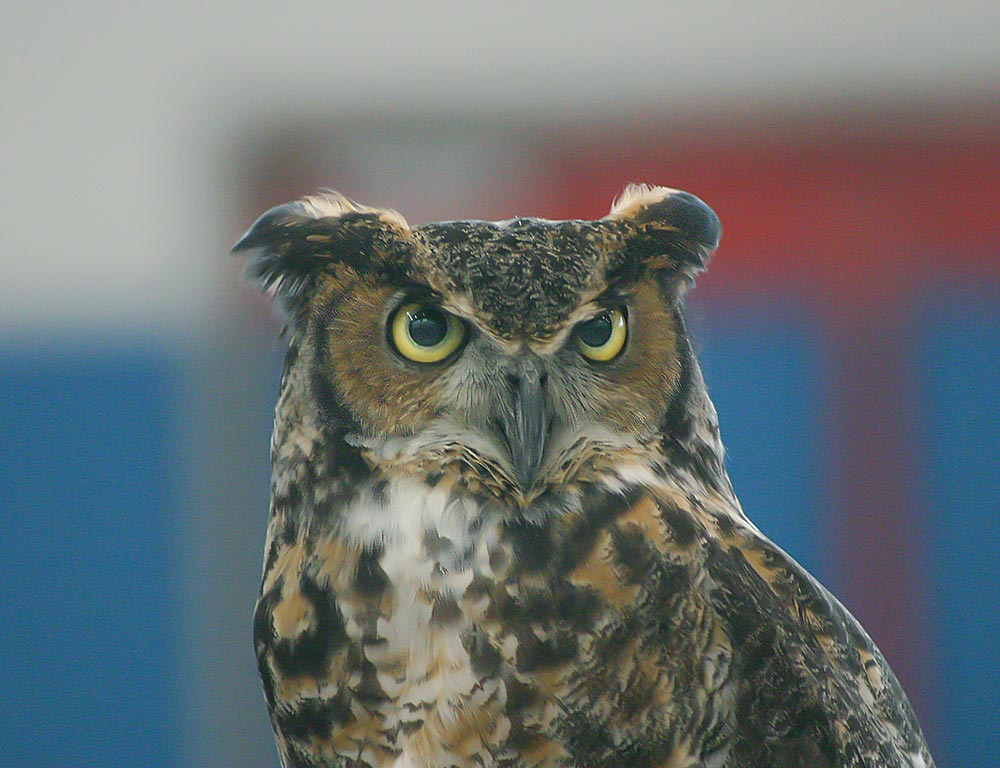
- Scientific name: Bubo virginianus
- Population: Stable
- Life span: 10-15 years
- Size: 18-25 inches
- Weight: 2-5.5 pounds
- Food: Diverse diet, including mammals, birds, and reptiles
- Wingspan: 3.3-4.8 feet
- Status: Common
The Great Horned Owl (Bubo virginianus) is a formidable bird with distinctive ear tufts. In Kentucky, their population remains stable.
With a life span of 10-15 years, these large owls have a size range of 18-25 inches, a weight between 2- 5.5 pounds, and an impressive wingspan of 3.3-4.8 feet.
Great Horned Owls are versatile predators, preying on mammals, birds, and even reptiles. Their adaptability to diverse habitats, from forests to urban areas, contributes to their common status in Kentucky.
These owls often nest in abandoned nests of other large birds or even on cliffs. Despite their resilience, habitat destruction and collisions with vehicles threaten their population.
3. Barred Owl
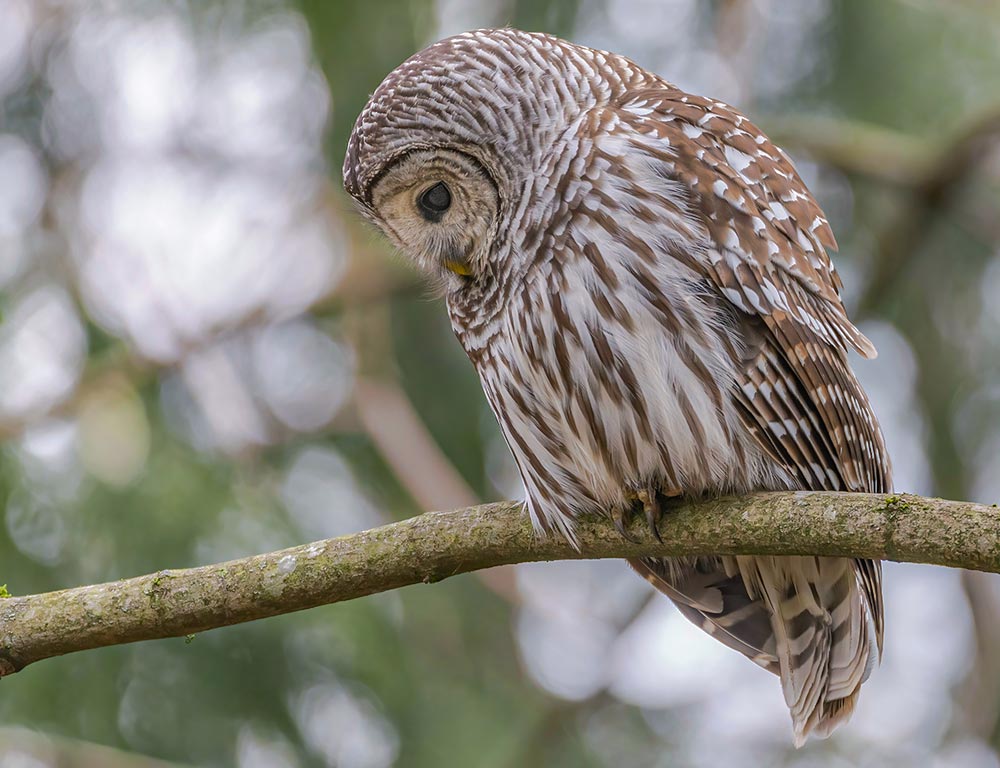
- Scientific name: Strix varia
- Population: Stable
- Life span: 10 years
- Size: 16-25 inches
- Weight: 1-2.5 pounds
- Food: Small mammals, birds, amphibians, and invertebrates
- Wingspan: 3.3-3.8 feet
- Status: Common
The Barred Owl (Strix varia) is recognized by its distinctive “who-cooks-for-you, who-cooks-for-you-all” call. In Kentucky, their population remains stable.
With a life span of 10 years, these medium to large-sized owls have a size range of 16-25 inches, a weight of 1-2.5 pounds, and a wingspan of 3.3-3.8 feet.
Barred Owls are opportunistic hunters, feeding on small mammals, birds, amphibians, and invertebrates. Their adaptability to both mature and secondary forests and urban areas contributes to their common status in Kentucky.
These owls typically nest in tree cavities, and while they face some threats like habitat loss, they generally thrive in various environments.
4. Eastern Screech Owl
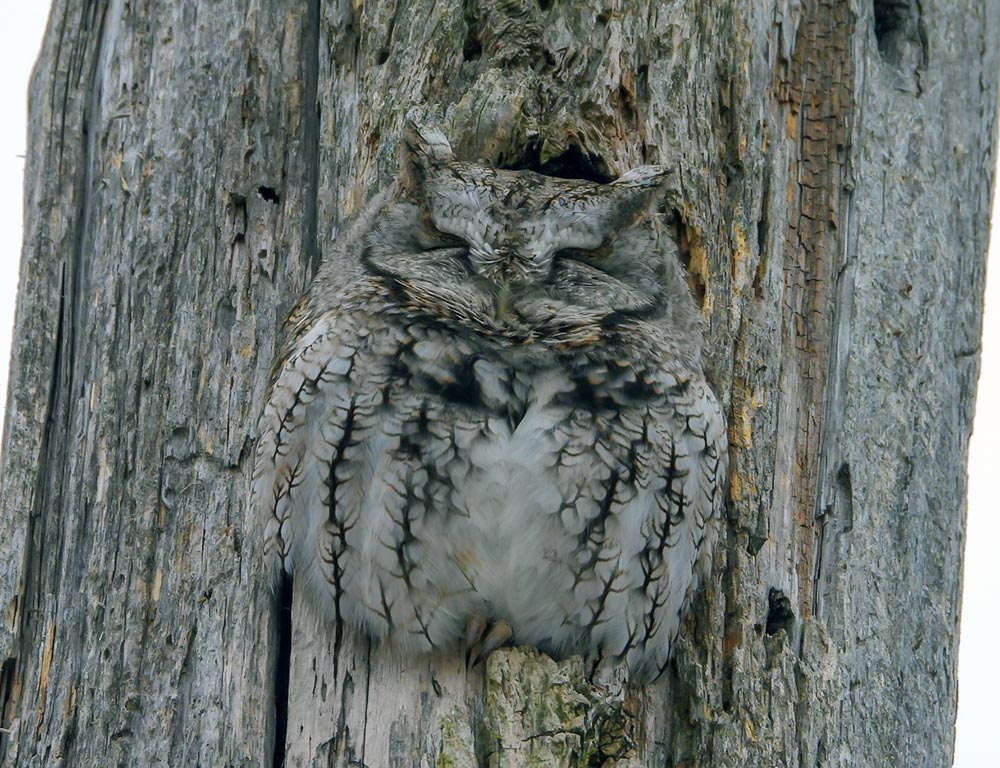
- Scientific name: Megascops asio
- Population: Common
- Life span: 5-14 years
- Size: 6-10 inches
- Weight: 4-9 ounces
- Food: Small mammals, birds, insects
- Wingspan: 18-24 inches
- Status: Secure
The Eastern Screech Owl (Megascops asio) is a small owl species found in various habitats across Kentucky. Their population is common, and they have a life span ranging from 5 to 14 years.
These owls measure between 6 to 10 inches, with a weight of 4 to 9 ounces and a wingspan ranging from 18 to 24 inches.
Eastern Screech Owls are adaptable hunters, preying on small mammals, birds, and insects. Their excellent camouflage and nocturnal habits make them proficient in hunting at night.
These owls often nest in tree cavities, displaying a preference for wooded areas. Despite urbanization impacting some of their habitats, their overall population remains secure.
5. Snowy Owl
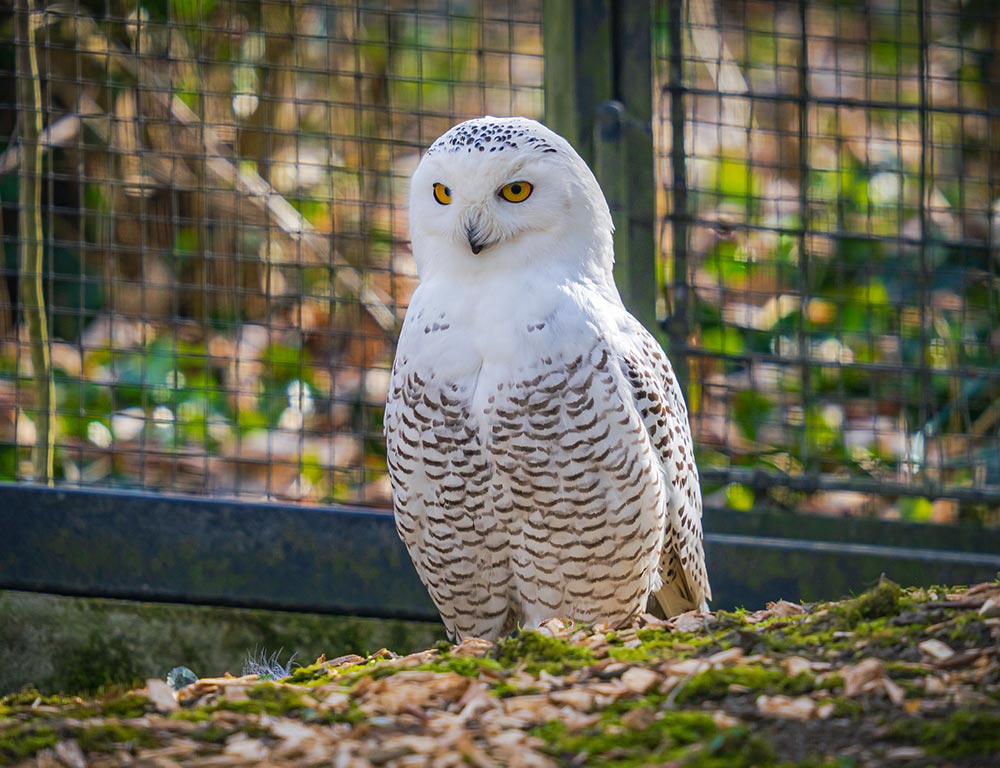
- Scientific name: Bubo scandiacus
- Population: Varies, but declining
- Life span: 10 years
- Size: 20-28 inches
- Weight: 3-6.6 pounds
- Food: Mainly lemmings, also birds and small mammals
- Wingspan: 4.2-4.8 feet
- Status: Vulnerable in some regions
The Snowy Owl (Bubo scandiacus) is an iconic, Arctic-dwelling owl that occasionally visits Kentucky during winter. Their population varies, but in some regions, it is declining.
These large owls have a life span of around ten years, a size range of 20 to 28 inches, a weight between 3 to 6.6 pounds, and an impressive wingspan of 4.2 to 4.8 feet.
Snowy Owls primarily feed on lemmings in their Arctic habitats. They may also prey on birds and small mammals when they migrate south.
Climate change, disturbance in breeding grounds, and human interference contribute to their vulnerable status in some regions.
6. Long-eared Owl
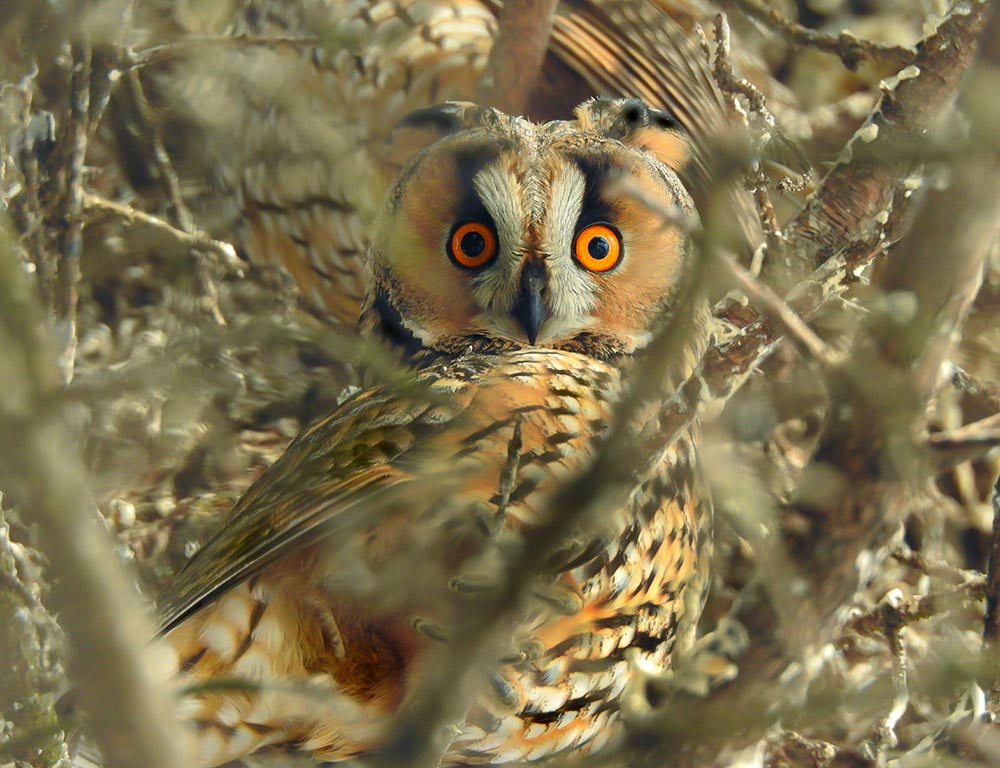
- Scientific name: Asio otus
- Population: Stable
- Life span: 4-10 years
- Size: 13-16 inches
- Weight: 7-15 ounces
- Food: Small mammals, birds
- Wingspan: 35-39 inches
- Status: Secure
The Long-eared Owl (Asio otus) is a medium-sized owl found in Kentucky, with a stable population. Their life span ranges from 4 to 10 years, and they measure between 13 to 16 inches, with a weight of 7 to 15 ounces and a wingspan of 35 to 39 inches.
Long-eared Owls are primarily nocturnal hunters, preying on small mammals and birds. They prefer woodlands and open country habitats.
Though their population is generally secure, habitat loss and disturbance during the breeding season can affect their well-being. Conservation efforts to protect their nesting sites contribute to maintaining their stable status.
7. Short-eared Owl
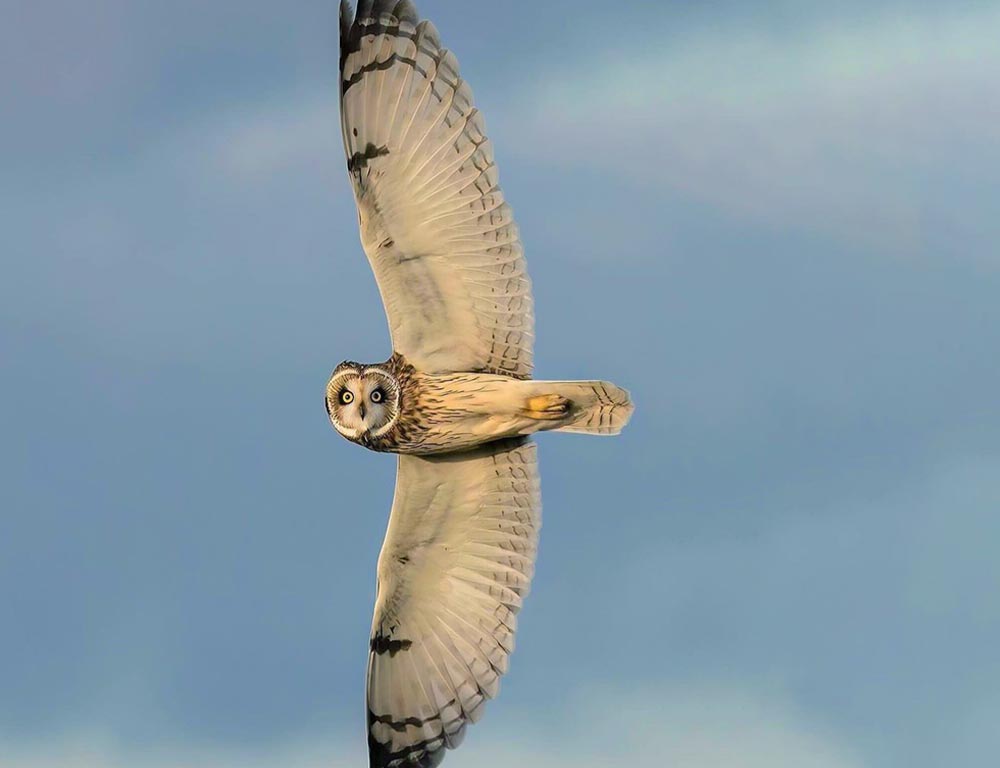
- Scientific name: Asio flammeus
- Population: Variable, declining
- Life span: 3-5 years
- Size: 13-17 inches
- Weight: 7-16 ounces
- Food: Small mammals, birds
- Wingspan: 33-43 inches
- Status: Declining
The Short-eared Owl (Asio flammeus) is a medium-sized owl with distinctive ear tufts. Their population varies, but overall, it is declining.
Short-eared Owls have a relatively short life span of 3 to 5 years, measuring between 13 and 17 inches, weighing 7 to 16 ounces, and featuring a wingspan of 33 to 43 inches.
Primarily found in grasslands and marshes, Short-eared Owls hunt small mammals and birds. Loss of habitat due to agricultural development and urbanization contributes to their declining status.
Conservation efforts focusing on preserving their preferred habitats are crucial for their survival.
8. Northern Saw-whet Owl
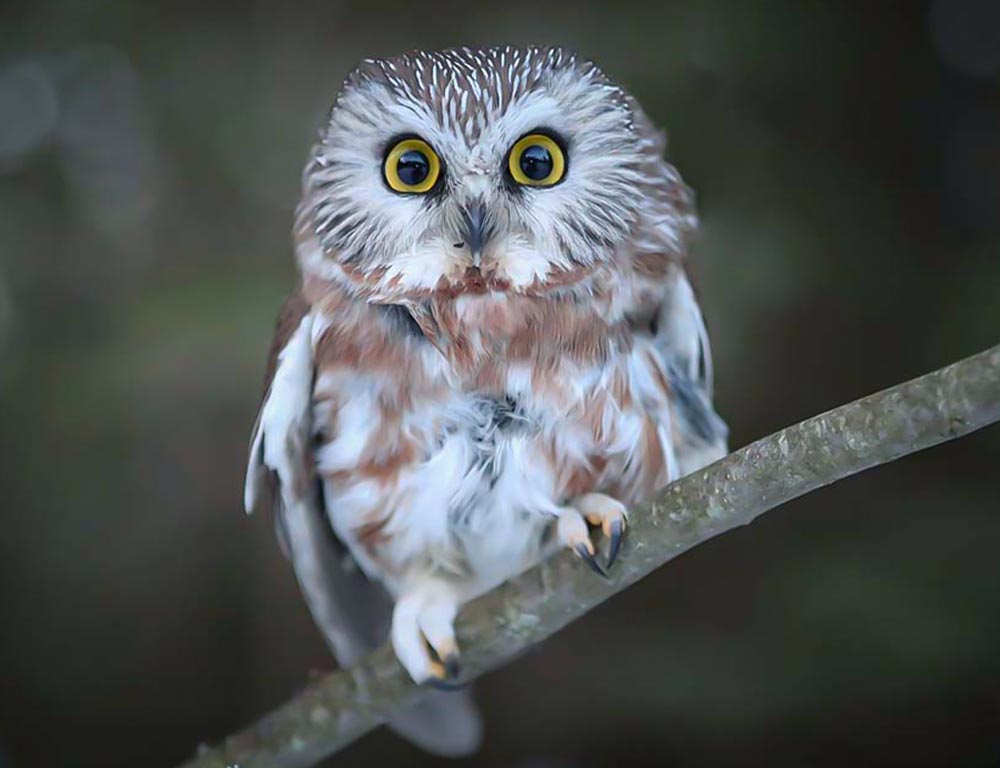
- Scientific name: Aegolius acadicus
- Population: Stable
- Life span: 7 years
- Size: 7-8 inches
- Weight: 2-5 ounces
- Food: Small mammals, birds, insects
- Wingspan: 16-20 inches
- Status: Secure
The Northern Saw-whet Owl (Aegolius acadicus) is a small, secretive owl species with a stable population. These owls have a life span of around 7 years, measuring between 7 and 8 inches, weighing 2 to 5 ounces, and featuring a wingspan of 16 to 20 inches.
Found in various wooded habitats, Saw-whet Owls primarily prey on small mammals, birds, and insects. They are excellent at camouflage, making them challenging to spot in their dense forest environments.
While their population is generally secure, conserving mature forests is crucial for maintaining their stability.
Where to Spot Owls in Kentucky?
Finding out the mystical world of owls in Kentucky can be a thrilling experience for nature enthusiasts and birdwatchers alike.
The diverse ecosystems of the state provide a haven for various owl species. Here are some prime locations where you can spot these nocturnal wonders in Kentucky:
Land Between the Lakes National Recreation Area
Nestled between Kentucky Lake and Lake Barkley, this expansive area offers diverse habitats, attracting owls like the barred owl and great horned owl. Listen to their distinctive calls echoing through the woodlands during evening hikes.
Mammoth Cave National Park
The extensive cave systems and surrounding forests create an ideal environment for owls, including the eastern screech owl. Explore the park’s trails after dusk to glimpse these feathered inhabitants.
Bernheim Arboretum and Research Forest
Known for its biodiversity, Bernheim Forest is a haven for owls like the barred owl and barn owl. Participate in guided owl prowls organized by the park to enhance your chances of spotting these elusive creatures.
Clarks River National Wildlife Refuge
This wildlife refuge, encompassing bottomland hardwood forests and wetlands, provides a habitat for owls such as the eastern screech owl and barred owl. Join guided birdwatching tours to enhance your owl-spotting experience.
Jefferson Memorial Forest
This forest is near Louisville and home to various owl species, including the great horned owl. Attend educational programs the forest offers to gain insights into owl behaviors and increase your chances of encounters.
Kentucky Horse Park
The mix of open fields and woodlands at the Kentucky Horse Park attracts owls like the eastern screech owl. Explore the park during evening hours to witness these owls in action, hunting for prey on the expansive grounds.
Carter Caves State Resort Park
This park’s intricate cave systems and surrounding woodlands create an ideal setting for owls like the eastern screech owl. Join nighttime guided tours to witness these elusive birds in their natural habitat.
Embark on a nocturnal adventure across Kentucky’s enchanting landscapes, and you might witness these fascinating owls’ silent flight and captivating presence.
Wrapping Up
The mesmerizing world of owls unfolds in the darkened forests and expansive parks of Kentucky.
From the haunting calls of the barred owl to the stealthy flight of the great horned owl, these creatures add an enchanting dimension to the state’s rich biodiversity.
Exploring the carefully selected locations mentioned provides a unique opportunity to witness these nocturnal hunters in their natural habitats.
As stewards of these ecosystems, it’s crucial to appreciate and conserve these avian wonders. By understanding their behaviors and habitats, we contribute to preserving these mystical birds for future generations to admire.
So, whether you’re a seasoned birdwatcher or a nature enthusiast, venture into the Kentucky wilderness to immerse yourself in the captivating world of owls. Thank you so much.